Knowledge-based Configuration: From Research to Business Cases, FIRST EDITION (2014)
Part III. Advanced Topics
Chapter 13. Personalized Configuration
Juha Tiihonena, Alexander Felfernigb and Monika Mandlb, aAalto University, Aalto, Finland, bGraz University of Technology, Graz, Austria
Abstract
The increasing size and complexity of products (or product assortments) triggers a demand for intelligent techniques that proactively support users of configurator applications in finding a solution (configuration) that fits their wishes and needs. Recommendation technologies are predestined to be applied in the configuration context, because they can find relevant items from large and complex item sets. In this chapter, we show how different types of basic recommendation technologies can be applied to recommend configurations or individual selections such as attribute values to the user of a configurator. This discussion is based on a working example from the domain of mobile phones.
Keywords
Knowledge-based Configuration; Recommender Systems; Recommendation Techniques; Personalized Diagnosis; Personalized Repairs; Result Ranking
13.1 Introduction
Configuration systems (configurators for short; Barker et al., 1989; Heiskala et al., 2007; Stumptner, 1997) have become an important instrument to implement the concepts of mass customization (see Piller and Blazek, 20141). The basic concept of mass customization is the production of customer-individual products with near Mass Production efficiency (Pine, 1993; Tseng and Jiao, 2001). Following the paradigm of mass customization, the intelligent customizing of products and services is crucial for manufacturing companies to stay competitive. Configurators support the idea of integrating the user in the design process by allowing the specification (design) of desired product features; subsequent production processes take into account this individualized design. Instead of choosing a product, a user of a configurator specifies a product by configuring the product attributes based on a set of available options. Example domains where configurators are applied are computers, cars, industrial machinery, financial services, and telecommunication switches.
Configurators have many advantages such as the elimination of errors, shorter product delivery cycles, and increased productivity of sales representatives (see Bagley et al., 20142). A major drawback of product configurators is that users (customers) in many cases have the problem of not fully understanding the set of offered options and are often overwhelmed by the complexity of these options (Bettman et al., 1998; Huffman and Kahn, 1998). The purpose of this chapter is to present a selected set of strategies to support users throughout the configuration process by integrating (exploiting) recommendation technologies (see, for e.g., (Cöster et al., 2002; Falkner et al., 2011; Felfernig et al., 2010; Geneste and Ruet, 2001; Tiihonen and Felfernig, 2010).
The major contributions of this chapter are the following. We motivate the need for the integration of recommender systems with configurators. In this context, we show how to integrate basic recommendation approaches within a configuration process on the basis of a working example.
The remainder of this chapter is organized as follows. First, we introduce relevant concepts of knowledge-based configuration on the basis of a working example from the domain of mobile phones (Section 13.2). Next, we discuss several existing approaches to integrate recommendation technologies in configurators (Section 13.3). Finally, we discuss future research issues in Section 13.4 and conclude this chapter with Section 13.5.
13.2 Example
The task of identifying a configuration for a set of user requirements can be defined as follows (this definition is based on the one given in Hotz et al., 20143).
Definition
Configuration Task
A configuration task can be defined as a constraint satisfaction problem (V, D, C). ![]() represents a set of finite domain variables and
represents a set of finite domain variables and ![]() represents a set of domains, where
represents a set of domains, where ![]() is assigned to
is assigned to ![]() .
. ![]() represents a set of constraints, where
represents a set of constraints, where ![]() represents the configuration knowledge base that restricts the possible combinations of values assigned to the variables in V, and
represents the configuration knowledge base that restricts the possible combinations of values assigned to the variables in V, and ![]() represents user requirements.
represents user requirements.
An example of a configuration task in the mobile phone domain is illustrated in Figure 13.1. Here ![]() {styleReq, webUse, GPSReq, pModel, pStyle, pHSDPA, pGPS, pPrice}, where styleReq expresses the user’s preferred phone style, webUse specifies how often the user intends to access the Internet and GPSReq specifies whether the user wants to use GPS navigation functionality. The remaining attributes define specific properties of a mobile phone (Phone).
{styleReq, webUse, GPSReq, pModel, pStyle, pHSDPA, pGPS, pPrice}, where styleReq expresses the user’s preferred phone style, webUse specifies how often the user intends to access the Internet and GPSReq specifies whether the user wants to use GPS navigation functionality. The remaining attributes define specific properties of a mobile phone (Phone).
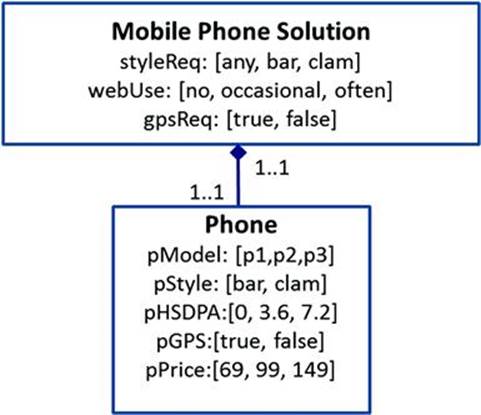
FIGURE 13.1 UML configuration model of the mobile phone domain (product structure).
Table 13.1 specifies phone models that can be part of a configuration. The related variable domains are the following: ![]() .
.
Table 13.1
Phone models in the working example: pModel specifies the existing phone models, pStyle the phone styles, pHSDPA specifies the supported HSDPA data rate (a value of 0 indicates that the phone does not support HSDPA), pGPS whether the phone supports GPS navigation, and pPrice specifies the price of the phone.
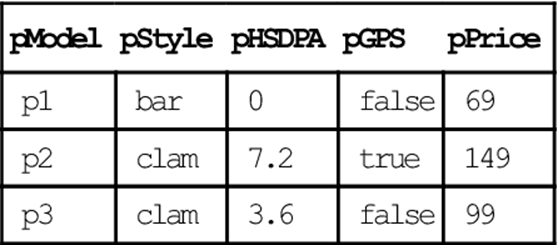
Furthermore, we introduce a set of domain constraints ![]() . Table 13.1 can be interpreted as a compatibility constraint (see Hotz et al., 20144) represented in disjunctive normal form, which yields
. Table 13.1 can be interpreted as a compatibility constraint (see Hotz et al., 20144) represented in disjunctive normal form, which yields ![]() . The remaining constraints represent the following domain properties.
. The remaining constraints represent the following domain properties.
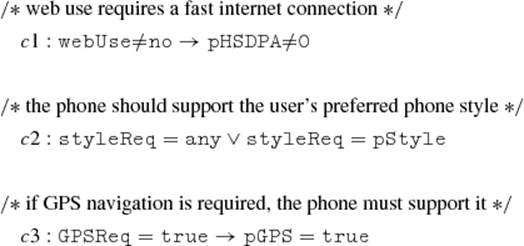
Finally, an example of user requirements is ![]() {
{![]() : styleReq=clam,
: styleReq=clam, ![]() : webUse=often,
: webUse=often, ![]() : GPSReq=false}.
: GPSReq=false}.
Based on this characterization of a configuration task, we now introduce the concept of a corresponding configuration. A solution (configuration) for a configuration task (V, D, C) is an instantiation ![]() , where
, where ![]() . A configuration is consistent if the assignments in I are consistent with the constraints in C. A configuration is complete if all the variables in V have a concrete value, and, finally, a configuration is valid if it is both consistent and complete.
. A configuration is consistent if the assignments in I are consistent with the constraints in C. A configuration is complete if all the variables in V have a concrete value, and, finally, a configuration is valid if it is both consistent and complete.
An example of a valid configuration is the following: {styleReq=clam, webUse=often, GPSReq=false, pModel=p3, pStyle=clam, pHSDPA=3.6, pGPS=false, pPrice=99}.
13.3 Integrating Recommendation Technologies to Configurators
A side effect of the high diversity of products that can be specified with a configurator is that the complexity of the offering may outstrip a user’s capability to explore the solution space and to make a buying decision. Previous research shows that consumers are often overwhelmed by the large amount of options (Malhotra, 1982). Since humans have limited processing capacity, confronting consumers with too much information can lead to an information overload and, therefore, can result in decreased quality of decision performance (Jacoby et al., 1974). Another challenge is that users often have no clear knowledge of what solution might fulfill their needs (Bettman et al., 1998). The theory of preference construction (Bettman et al.) explains that users typically do not know exactly which products or components they like (see also Mandl et al., 20145). As a consequence, users construct and adapt their preferences within the scope of a configuration process (Bettman et al., 1998).
Recommendation technologies can support users in the specification of their requirements and thus can help to achieve a higher user satisfaction (Cöster et al., 2002; Felfernig et al., 2010; Geneste and Ruet, 2001). The integration of recommendation technologies with knowledge-based configuration is still in a very early stage. There exist some contributions that take into account the application of personalization technologies in the configuration context. Geneste and Ruet (2001) introduce an approach to the integration of case-based reasoning methods (Kolodner, 1993; McSherry, 2003) with constraint solving (Tsang, 1993; Mackworth, 1977). Cöster et al. (2002), Tiihonen and Felfernig (2010), and Felfernig et al. (2010) focus on the recommendation of features, feature values, and strategies to integrate these recommendations in the user interface.
Next, we will discuss selected approaches to support users interacting with a configuration environment by the application of recommendation technologies.
13.3.1 Default Recommendations
In the remainder of this chapter, defaults refer to preselected feature values that represent recommended, meaningful alternatives that are compatible with the current user preferences. Defaults support the idea that users specify only those features which are important for them and let the system automatically determine values for the remaining ones (Falkner et al., 2011). Different approaches for recommending defaults are presented in the following paragraphs.
Static default recommendation. One interpretation of a static default is that a parameter has a predefined value that is independent of the configuration context. An alternative concept of static defaults has been introduced by McSherry (2005), who determines static recommendations for items based on the idea that most users would like to maximize or minimize values of numeric product attributes. These attributes are denoted as more-is-better (MIB; e.g., resolution or optical zoom of digital cameras) or less-is-better (LIB; e.g., price or weight) attributes. Furthermore, for some attributes users prefer a high similarity between their preferences and the corresponding product attributes. An example of such a nearer-is-better (NIB) attribute is pGPS: if the user expects the availability of GPS, the configuration should include this feature. A default query specifies the optimal product; it consists of the following preferences: the maximum values for MIB attributes, the minimum values for LIB attributes, and the user requirements for NIB attributes.
For our mobile phones example (Table 13.1) the preferred value for the LIB attribute pPrice is 69 (price of the cheapest available phone). The preferred value for pHSDPA is 7.2 (MIB; the highest available data rate). Finally, the preferred value for NIB attribute pGPS istrue assuming that the customer (user) requires GPS ![]() . The resulting default query is
. The resulting default query is ![]() .
.
The similarity of item I to the default query Q is determined with respect to each attribute a in Q. Formula 13.1 is used for MIB attributes, Formula 13.2 for LIB attributes, and Formula 13.3 for NIB attributes (McSherry, 2005). In these formulae, max(a) and min(a)refer to the maximum and minimum values of the attribute a in the case base. ![]() is the value of a in the (default) query Q and
is the value of a in the (default) query Q and ![]() is the value of a for the item I. In these formulae, Boolean attributes values false and true are interpreted as 0 and 1, respectively. The union of all attributes in the case base is
is the value of a for the item I. In these formulae, Boolean attributes values false and true are interpreted as 0 and 1, respectively. The union of all attributes in the case base is ![]() (the set of variables).
(the set of variables).
![]() (13.1)
(13.1)
![]() (13.2)
(13.2)
![]() (13.3)
(13.3)
Applying static default recommendation to the phones in Table 13.1 for the query ![]() , we calculate the similarities for the numeric attributes pPrice, pHSDPA, and pGPS (see Table 13.2).
, we calculate the similarities for the numeric attributes pPrice, pHSDPA, and pGPS (see Table 13.2).
Table 13.2
Static default recommendation for phone models of the working example. pModel is the phone model, pHSDPA is the supported HSDPA data rate, and ![]() is similarity value of the MIB attribute pHSDPA (Formula 13.1). pPrice is the price of the phone,
is similarity value of the MIB attribute pHSDPA (Formula 13.1). pPrice is the price of the phone,![]() is the similarity value of the LIB attribute pPrice (Formula 13.2). pGPS specifies if the phone supports GPS, and
is the similarity value of the LIB attribute pPrice (Formula 13.2). pGPS specifies if the phone supports GPS, and ![]() is the similarity value of the Boolean NIB attribute pGPS (Formula 13.3). Finally
is the similarity value of the Boolean NIB attribute pGPS (Formula 13.3). Finally ![]() represents
represents ![]() —the total similarity of pModel with regard to best values
—the total similarity of pModel with regard to best values ![]() .
.

Because the price is a LIB attribute, Formula 13.2 assigns the phone with the lowest price (p1) and the highest similarity 1 (with respect to Q). The phone with the highest price (p2) has a similarity of 0. Phone p3 has a similarity value of 0.625. For the MIB attributepHSDPA, we use Formula 13.1, and for the NIB attribute pGPS, Formula 13.3. Phone p2 has the highest similarity value of 2.000, and, therefore, p2 will be presented as the default recommendation. If some attributes are more important than others, it makes sense to take this into account by multiplying similarity values with attribute weight to provide a weighted similarity score. For a detailed discussion of related similarity metrics refer to Tiihonen and Felfernig (2010).
Rule-based default recommendation. The rule-based approach calculates defaults based on already specified user requirements and explicitly defined rules that embody domain knowledge for determining recommendations (Falkner et al., 2011). In our example of the mobile phone domain for example, we can specify the rule that if the user indicates that he/she often wants to use the mobile phone for browsing the web, the value for HSDPA is recommended to be set to the highest value:

Collaborative default recommendation. In this approach the system exploits information from already completed configuration sessions to recommend defaults for unspecified features to the current user. Tiihonen and Felfernig (2010) introduced and Felfernig et al. (2010) implemented an approach where the Nearest Neighbors and Naïve Bayes Voter algorithms were used to calculate collaborative default recommendations.
Nearest Neighbor based feature value recommendation finds a configuration of a previous user that is closest to the active user’s already specified requirements and recommends feature values of that nearest neighbor for the remaining features. To calculate distances between feature values (Tiihonen and Felfernig, 2010; Felfernig et al., 2010) apply the Heterogeneous Value Difference Metric (HVDM) from Wilson and Martinez (1997) to cope with both symbolic and numeric features.
The distance between the already specified user requirements ![]() and a neighbor configuration
and a neighbor configuration ![]() is the sum of individual distances (McSherry, 2003) between corresponding feature values
is the sum of individual distances (McSherry, 2003) between corresponding feature values ![]() , and
, and ![]() , weighted by feature importance weights
, weighted by feature importance weights ![]() (see Formula 13.4).
(see Formula 13.4).
 (13.4)
(13.4)
To provide an example of the Nearest Neighbor based approach, Table 13.3 contains three valid configurations ![]() , and
, and ![]() from previous configuration sessions. Let us assume that the current user has already specified the requirements
from previous configuration sessions. Let us assume that the current user has already specified the requirements ![]() . Intuitively, the nearest neighbor for this combination of requirements is
. Intuitively, the nearest neighbor for this combination of requirements is ![]() since the feature values of styleReq and webUse are identical with the values specified in
since the feature values of styleReq and webUse are identical with the values specified in ![]() . To predict a value for the feature GPSReq, we use the value specified in
. To predict a value for the feature GPSReq, we use the value specified in ![]() , i.e.,
, i.e., ![]() .
.
Table 13.3
Example: Valid configurations from previous sessions (![]() ).
).
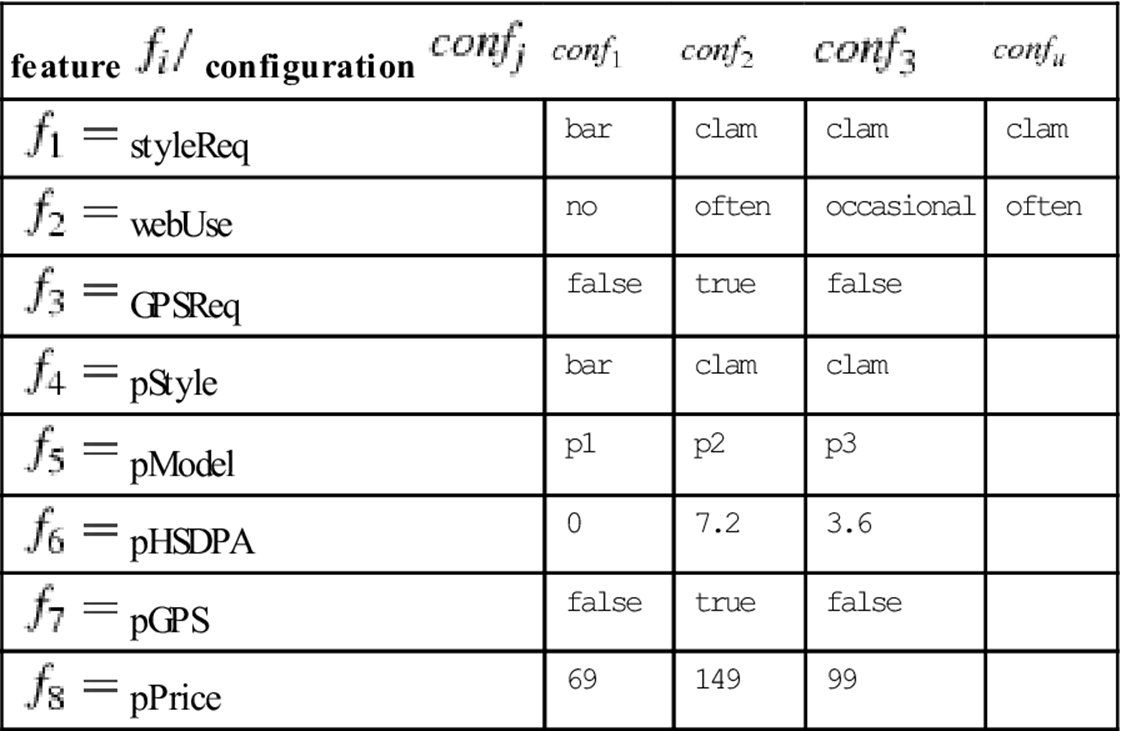
13.3.2 Ranking Results
If many solutions (configurations) exist for the given set of user requirements (which is typically the case), ranking heuristics are needed for selecting the solutions that are the most relevant ones for the user. Users are more likely to explore items that appear early in the results ranking; this effect is known as the primacy effect (see Mandl et al., 20146). Different result ranking approaches are discussed, for example, in Felfernig et al. (2008, 2010). Felfernig et al. (2010) introduce a similarity-based approach for ranking the products. Similarity of the user’s current configuration and already completed configurations is determined (determination of nearest neighbor configurations), which determines the order (ranking) of related phones. Phones that are consistent (compatible) with the current user requirements are shown in this order. For example, if the user requirements are ![]() , configuration
, configuration ![]() meets the user requirements (see Tables 13.1 and 13.3). Since
meets the user requirements (see Tables 13.1 and 13.3). Since ![]() is most similar to the user configuration (trivial case of one relevant configuration) the phone
is most similar to the user configuration (trivial case of one relevant configuration) the phone ![]() is ranked first.
is ranked first. ![]() cannot be recommended because its style does not match the user requirements.
cannot be recommended because its style does not match the user requirements.
Another approach to personalize item rankings was introduced in Felfernig et al. (2008). The approach utilizes Multi-Attribute Utility Theory (MAUT; Winterfeldt and Edwards, 1986) where products or, for example, individual attribute values are evaluated according to their performance on a predefined set of interest dimensions ![]() and user preferences. Example dimensions in the mobile phone scenario could be fashion (fa), economy (eco), and functionality (fu). Contribution of a product
and user preferences. Example dimensions in the mobile phone scenario could be fashion (fa), economy (eco), and functionality (fu). Contribution of a product ![]() to interest dimension
to interest dimension ![]() is predefined and expressed as score
is predefined and expressed as score ![]() . User preferences are expressed as interest with respect to each dimension
. User preferences are expressed as interest with respect to each dimension ![]() . The utility of a product
. The utility of a product ![]() can be determined, for example, on the basis of Formula 13.5.
can be determined, for example, on the basis of Formula 13.5.
![]() (13.5)
(13.5)
As a result, the order of products depends on the importance of the interest dimensions for the user. The importance of interest dimensions (![]() ) can be determined via explicit assessment provided by the user or be derived from user requirements (see, e.g.,Felfernig et al., 2013a). For simplicity, our example applies explicit interest dimension weights and assumes that values for
) can be determined via explicit assessment provided by the user or be derived from user requirements (see, e.g.,Felfernig et al., 2013a). For simplicity, our example applies explicit interest dimension weights and assumes that values for ![]() are manually specified for each product when the product database is established. Approaches to determine
are manually specified for each product when the product database is established. Approaches to determine ![]() automatically are discussed in Felfernig et al. (2006). An example of ranking phones based on MAUT is provided in Tables 13.4 and 13.5.
automatically are discussed in Felfernig et al. (2006). An example of ranking phones based on MAUT is provided in Tables 13.4 and 13.5.
Table 13.4
Scores of phone models with respect to interest dimensions. pModel is the phone model; ![]() ,
, ![]() , and
, and ![]() are scores for corresponding dimensions.
are scores for corresponding dimensions.

Table 13.5
Interests of two users with respect to predefined interest dimensions.
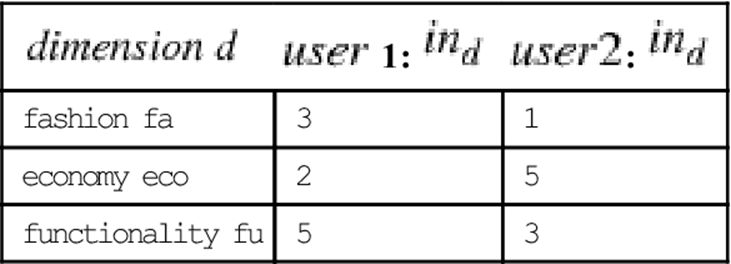
For user 1, utility of ![]() .
. ![]() , and
, and ![]() . For this user, who is mainly interested in functionality and less in economy, the most advanced phone
. For this user, who is mainly interested in functionality and less in economy, the most advanced phone ![]() provides the highest utility and would be shown first, followed by
provides the highest utility and would be shown first, followed by ![]() and
and ![]() . For user 2, the utilities are
. For user 2, the utilities are ![]() , and
, and ![]() . For this user. the cheapest phone
. For this user. the cheapest phone ![]() would be the first recommendation.
would be the first recommendation.
13.3.3 Recommendation of Repair Alternatives
If no configuration can be found for a given set of user requirements, a possible approach is to calculate and present diagnoses (repair alternatives; Felfernig et al., 2013a).7,8 A diagnosis is a set of user requirements that have to be removed or changed to enable finding a configuration; minimal diagnoses are of interest. Quite often a large number of alternative diagnoses are possible (Felfernig et al., 2009) and personalization can help to identify preferred alternatives. Let us assume that a user has the following set of requirements related to a mobile phone configuration: ![]() . From the available phone models in Table 13.1 we can infer that no solution (phone model) exists for the given set of requirements. Following the conflict detection and diagnosis techniques discussed in Felfernig et al. (2014)9 we are able to derive the following set of minimal conflicts:
. From the available phone models in Table 13.1 we can infer that no solution (phone model) exists for the given set of requirements. Following the conflict detection and diagnosis techniques discussed in Felfernig et al. (2014)9 we are able to derive the following set of minimal conflicts: ![]() and
and ![]() . Both sets are conflict sets since
. Both sets are conflict sets since ![]() is inconsistent, and
is inconsistent, and ![]() is inconsistent as well. Furthermore, both conflict sets are minimal since no subset of these sets is a conflict set.
is inconsistent as well. Furthermore, both conflict sets are minimal since no subset of these sets is a conflict set.
For each of the given minimal conflicts we have two possibilities to resolve the conflict. All the different alternative minimal diagnoses that can be determined from the given conflict sets are: ![]() and
and ![]() . Thus,
. Thus, ![]() and
and ![]() indicate the possibilities a user has to adapt (or delete) his/her requirements in a way that the configuration system is able to identify a solution.
indicate the possibilities a user has to adapt (or delete) his/her requirements in a way that the configuration system is able to identify a solution.
With some knowledge of the preferences of the user, we are able to rank the different alternative diagnoses and present the most relevant ones to the user. Since we have only two alternative diagnoses in our working example, we do not have to select the most relevant ones and only have to rank the two alternatives according to the preferences of the user. We determine the utility of a specific diagnosis ![]() for a user with Formula 13.6. Let us assume that the preference values shown Table 13.6 were provided by a user.
for a user with Formula 13.6. Let us assume that the preference values shown Table 13.6 were provided by a user.
 (13.6)
(13.6)
Table 13.6
Preferences of example user regarding mobile phone parameter values (obviously, price has the highest priority, i.e., should not be part of a diagnosis).

The utility function in Formula 13.6 can be used within the diagnosis process (see also Felfernig et al., 201410). The hitting set directed acyclic graph for determining a personalized (preferred) diagnosis is depicted in Figure 13.2. In this context, ![]() is the preferred diagnosis since it has the highest utility (
is the preferred diagnosis since it has the highest utility (![]() ). Alternative approaches to determine a preferred diagnosis for a set of inconsistent requirements are discussed in Felfernig et al. (2009, 2013b).
). Alternative approaches to determine a preferred diagnosis for a set of inconsistent requirements are discussed in Felfernig et al. (2009, 2013b).
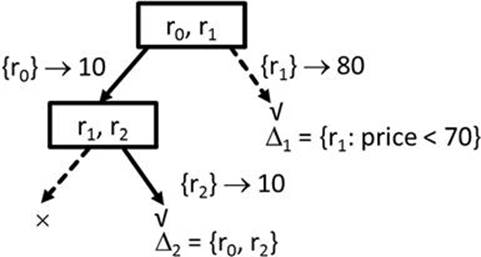
FIGURE 13.2 Preferred diagnosis for inconsistent requirements (![]() ):
): ![]() .
.
13.4 Research Challenges
The integration of personalization and recommendation technologies with configuration systems is still in its infancy. Next, we outline some of the primary topics for future research.
Decision phenomena. Psychological theories identify and explain different types of decision biases in consumer decision-making. Consumers are influenced by the format of the information presented and as a consequence use different decision-making strategies in different contexts. This implies that the design of the user interface can have a major impact on the final outcome of the decision-making process. In the context of result pages the focus of our future work is the investigation of the existence of decoy effects (see, e.g.,Huber et al., 1982). Decoy effects occur in situations where inferior (low-quality) decoy configurations are presented among other solutions. Effectively, decoys make other solutions ‘look better’. Decoys can trigger a significant shift in the solution selection (purchasing) behavior of users. We are interested in answering questions regarding the upper bound for the number of products such that decoy effects still occur. Furthermore, we are interested in the interrelationship between solution diversity (typically measured by different types of similarity metrics; McSherry, 2004) and the existence of decoy effects. A further question is whether the positioning of the decoy solution in a result set has an impact on the magnitude of the decision bias (decoy effect).
Advanced recommendation algorithms. Another topic for future work is to extend existing configuration-supporting recommendation algorithms to take into account structural variation of configurable products. This means to develop algorithms that do not rely on basic CSP representations but are also applicable with more complex, component-oriented product structures (see, e.g., the configuration model in Hotz et al., 2014).11 Furthermore, price and delivery time are often affected by numerous factors such as exact combination of options, and dynamic load of stakeholders such as manufacturing and supply chain. To take these aspects effectively into account when determining recommendations is a topic of future research.
Repair actions. If no configuration can be found for a given set of user requirements, numerous alternative combinations of repair actions exist that can resolve the conflict; the number is exponential in the number of requirements (O’Sullivan et al., 2007). A major goal for future work is to extend the approach of Felfernig et al. (2009) by additionally taking into account different types of decision biases that potentially occur in the repair selection process. For example, Kivetz and Simonson (2000) investigated the impact of incomplete information on consumer choice. A series of studies indicates that choosing from sets with missing information can influence consumers’ tastes and purchase decisions (Kivetz and Simonson, 2000). Repair actions can be regarded as incomplete information since repair alternatives typically include only a subset of the product attributes. In this context, we want to investigate whether the inclusion of additional attributes for explanation purposes can have an impact on the repair selection process.
Novel approaches to solution search. There exist two major approaches to search a large space of possible solutions. A query-based approach supports the specification of search criteria that have to be taken into account by the final solution; this is the typical approach supported by existing configuration environments. The other alternative to support users is to provide navigation-based interfaces that allow an easy navigation in the solution space. Such a navigation is supported by determining solutions that are similar to the currently presented solution and present this new solution to the user. Navigation-based interfaces are well established in the area of recommender systems (specifically critiquing-based ones). The applicability of these recommendation approaches in configuration scenarios is a major research issue.
13.5 Conclusion
In this chapter, we presented a selected set of recommendation strategies that help to personalize the product configuration experience by supporting users in configuring products according to their individual requirements. We discussed methods for the recommendation of feature values and the personalized ranking of configurations. We see our contribution as an important step on the way towards more intelligent configuration user interfaces that help to improve the quality of applications in different dimensions such as prediction accuracy or overall satisfaction with the configuration environment.
References
1. Bagley C, Felfernig A, Tiihonen J, Wortley L, Hotz L. Benefits of configuration systems. In: Felfernig A, Hotz L, Bagley C, Tiihonen J, eds. Knowledge-based Configuration – From Research to Business Cases. Waltham, MA: Morgan Kaufmann Publishers; 2014:29–33. (Chapter 4).
2. Barker V, O’Connor D, Bachant J, Soloway E. Expert systems for configuration at digital: XCON and beyond. Communications of the ACM. 1989;32(3):298–318.
3. Bettman J, Luce M, Payne J. Constructive consumer choice processes. Journal of Consumer Research. 1998;25(3):187–217.
4. Cöster C, Gustavsson A, Olsson R, Rudström A. Enhancing web-based configuration with recommendations and cluster-based help. In: Francesco R, Barry S, eds. AH’02 Workshop on Recommendation and Personalized in e-Commerce. Málaga, Spain: Universidad de Málaga; 2002:30–40.
5. Falkner A, Felfernig A, Haag A. Recommendation technologies for configurable products. AI Magazine. 2011;32(3):99–108.
6. Felfernig A, Friedrich G, Jannach D, Zanker M. An integrated environment for the development of knowledge-based recommender applications. International Journal of Electronic Commerce (IJEC). 2006;11(2):11–34.
7. Felfernig A, Gula B, Leitner G, Maier M, Melcher R, Teppan E. Persuasion in knowledge-based recommendation. In: Oinas-Kukkonen H, Hasle PFV, Harjumaa M, Segerståhl K, Øhrstrøm P, eds. Persuasive Technology, 3rd International Conference (PERSUASIVE 2008). Oulu, Finland: Springer; 2008:71–82. Lecture Notes in Computer Science vol. 5033.
8. Felfernig A, Schubert M, Friedrich G, Mandl M, Mairitsch M, Teppan E. Plausible repairs for inconsistent requirements. In: 21st International Joint Conference on Artificial Intelligence (IJCAI’09) Pasadena, CA, USA. 2009:791–796.
9. Felfernig A, Mandl M, Tiihonen J, Schubert M, Leitner G. Personalized user interfaces for product configuration. In: Rich C, Yang Q, Cavazza M, Zhou MX, eds. 15th ACM International Conference on Intelligent User Interfaces (IUI’2010). Hong Kong, China: ACM; 2010;317–320.
10. Felfernig A, Schippel S, Leitner G, et al. Automated repair of scoring rules in constraint-based recommender systems. AI Communications. 2013a;26(2):15–27.
11. Felfernig A, Schubert M, Reiterer S. Personalized diagnosis for over-constrained problems. In: 23rd International Conference on Artificial Intelligence Peking, China. 2013b:1990–1996.
12. Felfernig A, Reiterer S, Reinfrank F, Ninaus G, Jeran M. Conflict detection and diagnosis in configuration. In: Felfernig A, Hotz L, Bagley C, Tiihonen J, eds. Knowledge-based Configuration – From Research to Business Cases. Waltham, MA: Morgan Kaufmann Publishers; 2014:73–87. (Chapter 7).
13. Geneste L, Ruet M. Experience-based configuration. In: 17th International Conference on Artificial Intelligence, Workshop on Configuration Seattle, WA. 2001:45–49.
14. Heiskala M, Paloheimo K-S, Tiihonen J. Mass customization with configurable products and configurators: a review of benefits and challenges. In: Mass customization information systems in business. 1st ed IGI Global 2007:1–32. (Chapter 1).
15. Hotz L, Felfernig A, Stumptner M, Ryabokon A, Bagley C, Wolter K. Configuration knowledge representation and reasoning. In: Felfernig A, Hotz L, Bagley C, Tiihonen J, eds. Knowledge-based Configuration – From Research to Business Cases. Waltham, MA: Morgan Kaufmann Publishers; 2014:41–72. (Chapter 6).
16. Huber J, Payne W, Puto C. Adding asymmetrically dominated alternatives: violations of regularity and the similarity hypothesis. Journal of Consumer Research. 1982;9(1):90–98.
17. Huffman C, Kahn B. Variety for sale: mass customization or mass confusion. Journal of Retailing. 1998;74(4):491–513.
18. Jacoby J, Speller D, Kohn C. Brand choice behavior as a function of information load. Journal of Marketing Research. 1974;11(1):63–69.
19. Kivetz R, Simonson I. The effects of incomplete information on consumer choice. Journal of Marketing Research. 2000;37(4):427–448.
20. Kolodner J. Case-Based Reasoning. Waltham, MA: Morgan Kaufmann; 1993.
21. Mackworth A. Consistency in networks of relations. Artificial Intelligence. 1977;8(1):99–118.
22. Malhotra NK. Information load and consumer decision making. Journal of Consumer Research. 1982;8(4):419–430.
23. Mandl M, Felfernig A, Teppan E. Consumer decision making and configuration systems. In: Felfernig A, Hotz L, Bagley C, Tiihonen J, eds. Knowledge-based Configuration – From Research to Business Cases. Waltham, MA: Morgan Kaufmann Publishers; 2014:181–190. (Chapter 14).
24. McSherry D. Similarity and compromise. In: Ashley KD, Bridge D, eds. 5th International Conference on Case-Based Reasoning (ICCBR-03). Trondheim, Norway: Springer Verlag; 2003:291–305.
25. McSherry D. Maximally successful relaxations of unsuccessful queries. In: Lorraine M, Brian C, eds. 15th Irish Conference on Artificial Intelligence and Cognitive Science (AICS-04). Galway, Ireland: UCD; 2004:127–136.
26. McSherry D. Incremental nearest neighbour with default preferences. In: Norman C, ed. 16th Irish Conference on Artificial Intelligence and Cognitive Science (AICS-05). Portstewart, Northern Ireland: University of Ulster; 2005:9–18.
27. Nica I, Wotawa F, Ochenbauer R, Schober C, Hofbauer H, Boltek S. Kapsch: reconfiguration of mobile phone networks. In: Felfernig A, Hotz L, Bagley C, Tiihonen J, eds. Knowledge-based Configuration – From Research to Business Cases. Waltham, MA: Morgan Kaufmann Publishers; 2014:229–240. (Chapter 19).
28. O’Sullivan B, Papadopoulos A, Faltings B, Pu P. Representative explanations for over-constrained problems. In: Holte RC, Howe AE, eds. Twenty-Second AAAI Conference on Artificial Intelligence (AAAI-07). Vancouver, Canada: AAAI Press; 2007:323–328.
29. Piller FT, Blazek P. Core capabilities of sustainable mass customization. In: Felfernig A, Hotz L, Bagley C, Tiihonen J, eds. Knowledge-based Configuration – From Research to Business Cases. Waltham, MA: Morgan Kaufmann Publishers; 2014:107–120. (Chapter 9).
30. Pine BJ. Mass customization: The New Frontier in Business Competition. Harvard Business School Press 1993.
31. Stumptner M. An overview of knowledge-based configuration. AI Communications. 1997;10(2):111–126.
32. Tiihonen J, Felfernig A. Towards recommending configurable offerings. International Journal of Mass Customization. 2010;3(4):389–406.
33. Tsang E. Foundations of Constraint Satisfaction. London, San Diego, New York: Academic Press; 1993.
34. Tseng M, Jiao J. Mass customization. In: Salvendy G, ed. Handbook of Industrial Engineering. 3rd ed New York: Wiley; 2001:684–709. (Chapter 25).
35. Wilson D, Martinez T. Improved heterogenous distance functions. Journal of Artificial Intelligence Research. 1997;6:1–34.
36. Winterfeldt D, Edwards W. Decision Analysis and Behavioral Research. Cambridge: Cambridge University Press; 1986.
1Chapter 9.
2Chapter 4.
3Chapter 6.
4Chapter 6.
5Chapter 14.
6Chapter 14.
7For simplicity, we use the terms diagnosis and repair synonymously. Repairs often include not only the results of a diagnosis process but also concrete proposals of how to change a given set of inconsistent requirements. Such repairs are often denoted as reconfiguration (see Nica et al., 2014).
8See also (Chapter 7).
9Chapter 7.
10Chapter 7.
11Chapter 6.